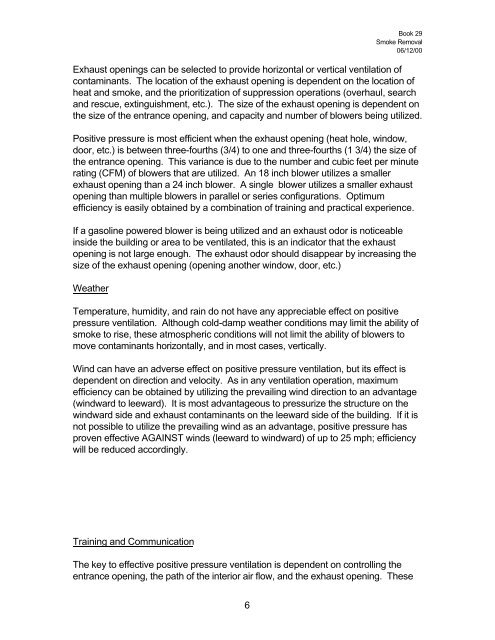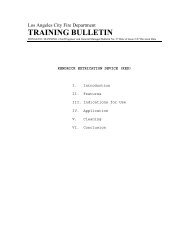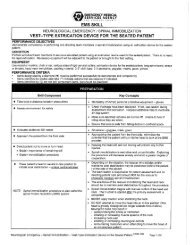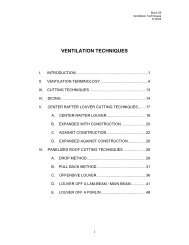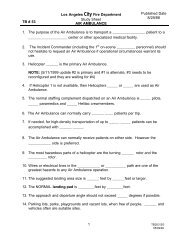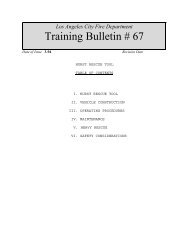SMOKE REMOVAL I. INTRODUCTION ... - LAFD Training
SMOKE REMOVAL I. INTRODUCTION ... - LAFD Training
SMOKE REMOVAL I. INTRODUCTION ... - LAFD Training
You also want an ePaper? Increase the reach of your titles
YUMPU automatically turns print PDFs into web optimized ePapers that Google loves.
6<br />
Book 29<br />
Smoke Removal<br />
06/12/00<br />
Exhaust openings can be selected to provide horizontal or vertical ventilation of<br />
contaminants. The location of the exhaust opening is dependent on the location of<br />
heat and smoke, and the prioritization of suppression operations (overhaul, search<br />
and rescue, extinguishment, etc.). The size of the exhaust opening is dependent on<br />
the size of the entrance opening, and capacity and number of blowers being utilized.<br />
Positive pressure is most efficient when the exhaust opening (heat hole, window,<br />
door, etc.) is between three-fourths (3/4) to one and three-fourths (1 3/4) the size of<br />
the entrance opening. This variance is due to the number and cubic feet per minute<br />
rating (CFM) of blowers that are utilized. An 18 inch blower utilizes a smaller<br />
exhaust opening than a 24 inch blower. A single blower utilizes a smaller exhaust<br />
opening than multiple blowers in parallel or series configurations. Optimum<br />
efficiency is easily obtained by a combination of training and practical experience.<br />
If a gasoline powered blower is being utilized and an exhaust odor is noticeable<br />
inside the building or area to be ventilated, this is an indicator that the exhaust<br />
opening is not large enough. The exhaust odor should disappear by increasing the<br />
size of the exhaust opening (opening another window, door, etc.)<br />
Weather<br />
Temperature, humidity, and rain do not have any appreciable effect on positive<br />
pressure ventilation. Although cold-damp weather conditions may limit the ability of<br />
smoke to rise, these atmospheric conditions will not limit the ability of blowers to<br />
move contaminants horizontally, and in most cases, vertically.<br />
Wind can have an adverse effect on positive pressure ventilation, but its effect is<br />
dependent on direction and velocity. As in any ventilation operation, maximum<br />
efficiency can be obtained by utilizing the prevailing wind direction to an advantage<br />
(windward to leeward). It is most advantageous to pressurize the structure on the<br />
windward side and exhaust contaminants on the leeward side of the building. If it is<br />
not possible to utilize the prevailing wind as an advantage, positive pressure has<br />
proven effective AGAINST winds (leeward to windward) of up to 25 mph; efficiency<br />
will be reduced accordingly.<br />
<strong>Training</strong> and Communication<br />
The key to effective positive pressure ventilation is dependent on controlling the<br />
entrance opening, the path of the interior air flow, and the exhaust opening. These


